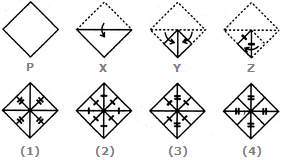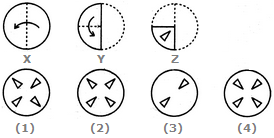Discussion
Home ‣ Non Verbal Reasoning ‣ Cubes and Dice See What Others Are Saying!
- Question
- If after 7 th step number of cubes painted in exactly 2 faces with colour 7 is 21, then what is the number of cubes removed in 3 rd step.
Options- A. 469
- B. 455
- C. 433
- D. None of these
- Correct Answer
- 469
ExplanationConsider the 1st step, initial number of cubes N3 after removal of 1st set of coloured cubes number of cubes left out is (N - 1)3 hence number of cubes removed in 1st step (i.e with colour 1) is
N3 - (N - 1)3 = 3N2 - 3N + 1
Similarly number of cubes removed in 2nd step (i.e with colour 2) is
Similarly number of cubes removed in 3rd step is (i.e with colour 3) and so on.
= 3(N - 1)2 - 3(N - 1) + 1
Number of cubes remaining after 1st step is (N - 1)3
Number of cubes remaining after 2nd step is (N - 2)3 and so on.
Total number of Cubes left after 7thstep in (N - 7)3 in the form of (N - 7) x (N - 7) x (N - 7) cubes.
And out of these number of cubes whose two sides are painted is given by three edges with each edge has (N - 8) so total number of cubes is 3 x (N - 8)
From the given information 3(N - 8) = 21 or N = 15
Number of cubes removed in 3rd step (i.e with colour 3) is = 3(N - 2)2 - 3(N - 2) + 1 = 469 - 1. Three different positions X, Y and Z of a dice are shown in the figures given below. Which number lies at the bottom face in position X?

Options- A. 2
- B. 3
- C. 6
- D. Cannot be determined Discuss
- 2. Choose the alternative which is closely resembles the mirror image of the given combination.

Options- A. 1
- B. 2
- C. 3
- D. 4 Discuss
- 3. Choose the figure which is different from the rest.
 (1) (2) (3) (4) (5)
(1) (2) (3) (4) (5)
Options- A. 1
- B. 2
- C. 3
- D. 4
- E. 5 Discuss
- 4. Find out the alternative figure which contains figure (X) as its part.
 (X) (1) (2) (3) (4)
(X) (1) (2) (3) (4)
Options- A. 1
- B. 2
- C. 3
- D. 4 Discuss
- 5. Choose a figure which would most closely resemble the unfolded form of Figure (Z).

Options- A. 1
- B. 2
- C. 3
- D. 4 Discuss
- 6. Choose the figure which is different from the rest.
 (1) (2) (3) (4) (5)
(1) (2) (3) (4) (5)
Options- A. 1
- B. 2
- C. 3
- D. 4
- E. 5 Discuss
- 7. Choose the figure which is different from the rest.
 (1) (2) (3) (4) (5)
(1) (2) (3) (4) (5)
Options- A. 1
- B. 2
- C. 3
- D. 4
- E. 5 Discuss
- 8. Select a suitable figure from the four alternatives that would complete the figure matrix.

Options- A. 1
- B. 2
- C. 3
- D. 4 Discuss
- 9. Choose a figure which would most closely resemble the unfolded form of Figure (Z).

Options- A. 1
- B. 2
- C. 3
- D. 4 Discuss
- 10. Select a figure from amongst the Answer Figures which will continue the same series as established by the five Problem Figures.
Problem Figures: Answer Figures:
 (A) (B) (C) (D) (E) (1) (2) (3) (4) (5)
(A) (B) (C) (D) (E) (1) (2) (3) (4) (5)
Options- A. 1
- B. 2
- C. 3
- D. 4
- E. 5 Discuss
More questions
Correct Answer: 3
Explanation:
As analysed above, the number on the face opposite 5 is 3. In position X, since 5 lies on the top, therefore 3 must lie at the bottom face.
Correct Answer: 4
Correct Answer: 1
Explanation:
Correct Answer: 2
Explanation:

Correct Answer: 2
Correct Answer: 5
Explanation:
Correct Answer: 2
Explanation:
Correct Answer: 3
Explanation:
Correct Answer: 4
Correct Answer: 1
Explanation:
 and
and
 alternately.
alternately.
Comments
There are no comments.Programming
Copyright ©CuriousTab. All rights reserved.
